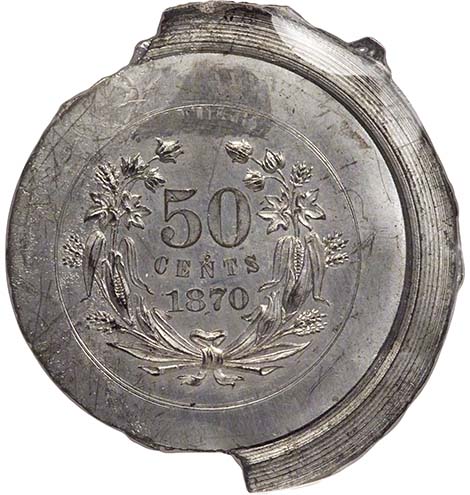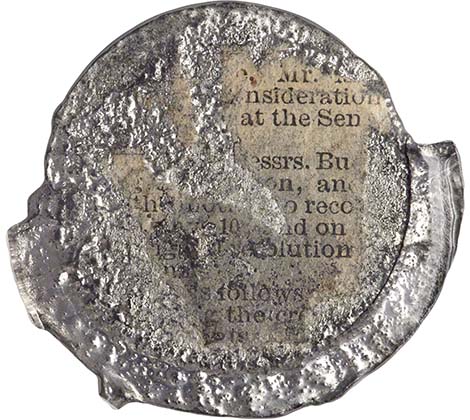The following coins sold in the September 2020 Important Selections from the Bob R. Simpson Collection, Part I #1310.
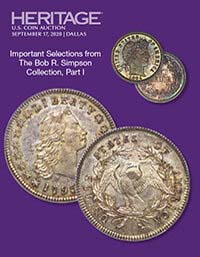
Images Courtesy of Heritage Auctions, HA.com
1862 Indian Cent, MS67
Stunning Obverse Die Cap
From the Harrison Phillips Collection
Sold for: $40,800.00
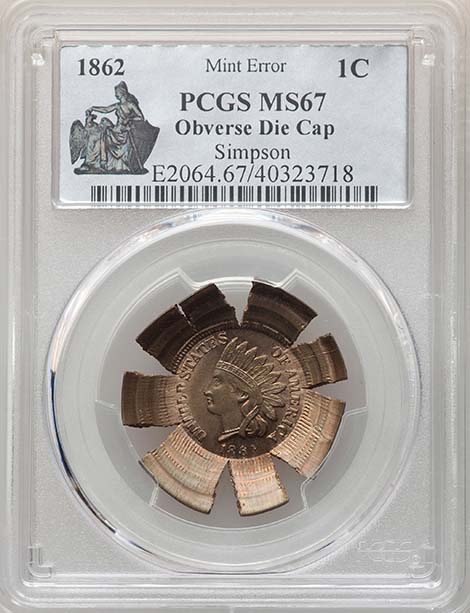
1862 Indian Cent -- Obverse Die Cap -- MS67 PCGS. Ex: Simpson. This is one of the most stunning and spectacular errors that we have seen or handled, a remarkable illustration of what can go wrong during coining operations. Although coinage presses in 1862 did not operate with nearly the same speed as modern-day presses, they could still strike quite a large number of coins every minute.
A die cap is created when a planchet literally sticks to the die through multiple press cycles. The successive cycle of the press, over a short period, probably seconds rather than minutes, caused the planchet to expand slightly, and the obverse detail to become just a little sharper in definition. As the metal expanded, it also became more brittle and eventually split into a fan shape with eight individual tabs. Clearly, the copper-nickel (in this case 12% nickel and 88% copper) was quite hard and contributed to the appearance that is now so coveted.
The obverse is exceptionally sharp, especially at the center, with every feather tip and every diamond fully and completely defined. The legend and date are drawn to the border, with the border design extensively drawn out onto the individual tabs. This Superb Gem is highly lustrous with wonderful tan color accented by light blue color in the fields. This is a uniface example with no design visible on the reverse, possibly the result of two planchets fed into the press at the same time, but more likely the repeated blows of the die cap that caused the reverse design to expand and eventually disappear entirely. For the connoisseur who appreciates the combination of impressive quality and outrageous character. This amazing piece is recorded as number three in the 100 Greatest U.S. Error Coins reference by Nicholas P. Brown, David J. Camire, and Fred Weinberg.
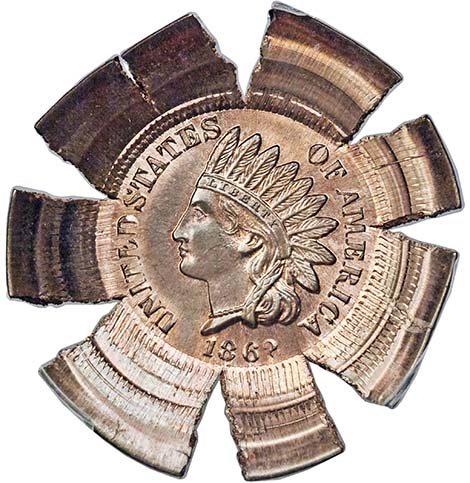
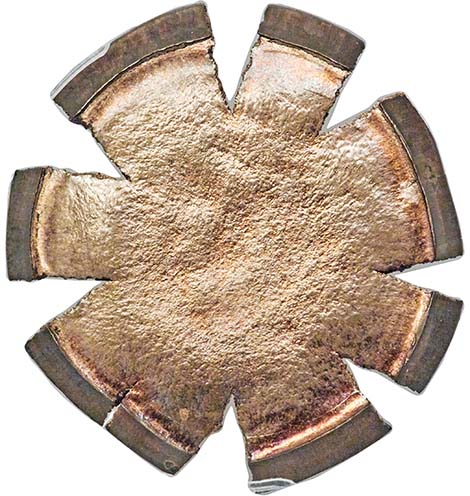
1796 Quarter Eagle in White Metal
Judd-23a, Private Restrike, MS63
Sold for: $156,000.00
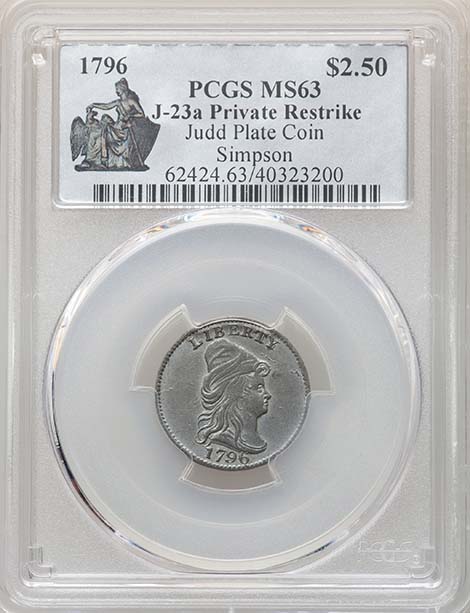
1796 Quarter Eagle, Judd-23a, Private Restrike, Pollock-6035, Unique, MS63 PCGS. Ex: Simpson. This piece might appear to be a dies trial strike, but it is actually a 1796 quarter eagle struck in white metal from rusted dies. Undoubtedly it was produced either by Joseph Mickley or Montroville Dickeson from dies sold as scrap by the Mint. The Judd reference puts the striking of this piece is its proper perspective:
"There are no known patterns dated 1796, although this was a pivotal year for the introduction of new denominations -- the dime, quarter dollar, and quarter eagle. Without doubt, different trial pieces must have been made for the new denominations. No records of any exist today. [This] piece ... is a later restrike that bears the date 1796, but has no connection with true patterns of that year."
Joseph Mickley would seem like the most likely suspect for the production of this piece. Mickley was well known for his purchase of old dies from the Mint and later restriking of various fanciful pieces. In his defense, the die rust on his various concoctions is so extensive that there is no comparable coin struck in the year of issue that it could be confused with. In other words, there was no intent to deceive. Nor was this piece intended to deceive anyone. The illogical combination of extensive die rust on an off-metal strike, presumably made prior to regular coin production, simply does not make sense. As Dr. Judd stated, " ... different trial pieces must have been made for the new denominations." This restrike gives us an idea what such a trial piece might have looked like. The surfaces are softly defined on each side. The white metal itself is surprisingly well preserved with only slight, uniform mellowing to a medium gray color. This is an interesting piece that would fit into many different collections. It could certainly find a home in a pattern collection, or just as easily in a set of early quarter eagles or a set of 1796 coinage. This piece's unique status is hard to argue with and it will certainly bring a commanding price when sold this summer.
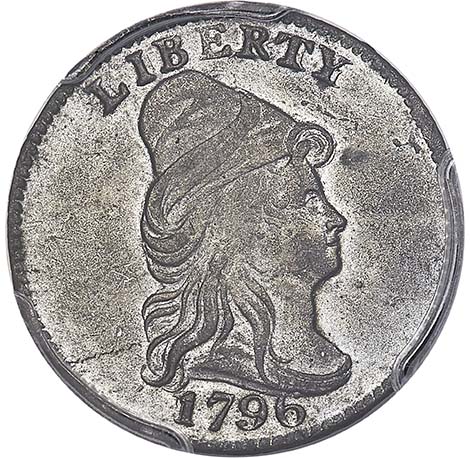
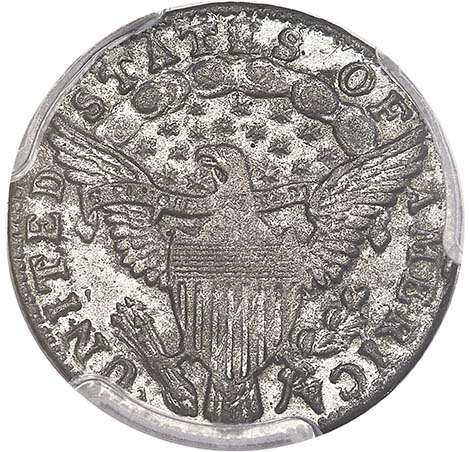
1846 Quarter Eagle Dies Trial
Struck on a Half Eagle Planchet, Then Struck Again
Judd-110A, Unique, MS65 Brown
Sold for: $33,600.00
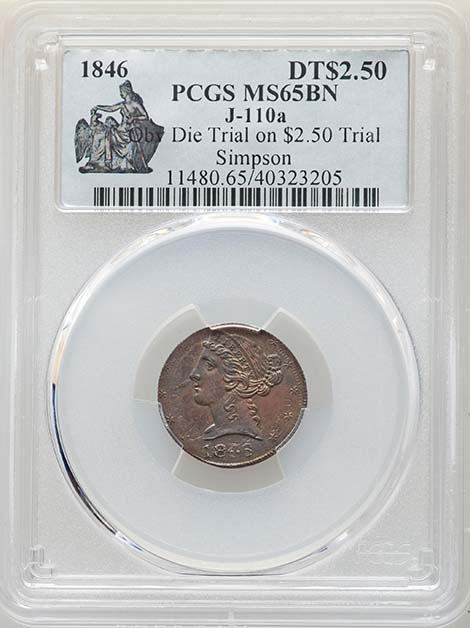
1846 Quarter Eagle, Judd-110A, Pollock-124, Unique, MS65 Brown PCGS. Ex: Simpson. 38.0 grains. The 1840s is a desolate decade for U.S. Mint patterns. Aside from a few 1849 patterns, such as the famous Longacre-designed double eagle, there are no patterns from the 1840s, with two exceptions. Judd-110 is a unique, undated, and unfinished hub impression for a Seated quarter. Judd-110a is also unique, and important as the only dated pattern between 1840 and 1848. Struck in copper with reeded edge, this piece was initially a dies trial for the 1846 quarter eagle. USPatterns.com gives the best summation of what happened to create this unique piece:
"After being struck as a quarter eagle, the coin appears to have been placed on top of a half eagle planchet and was then struck by half eagle dies. This is known as a piggy-back rider error. The coin was aligned such that the half eagle obverse was struck over the reverse side of the quarter eagle die trial. Although the quarter eagle obverse was flattened by the half eagle planchet underneath, both dates are clearly visible."
The surfaces are glossy brown with just a trace of underlying mint red in evidence.
Ex: ANA Auction (New Netherlands, 8/1952), lot 4478; Stetson University Collection (Bowers and Merena, 5/1993), lot 2429; Mike Byers.
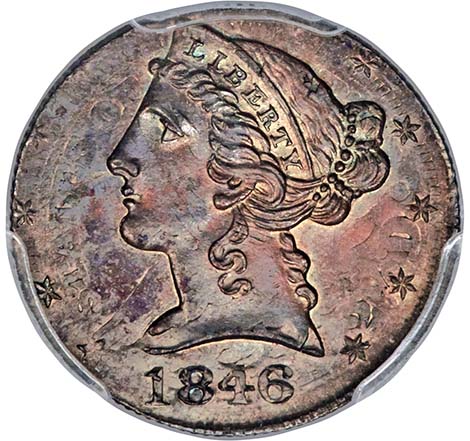
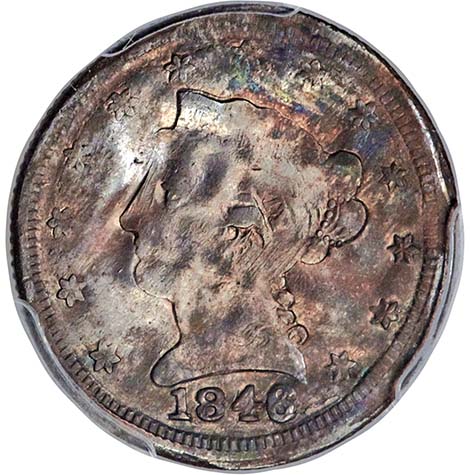
1858 Flying Eagle / Indian Cent Mule
Judd-220, PR64
Unique
Sold for: $36,000.00
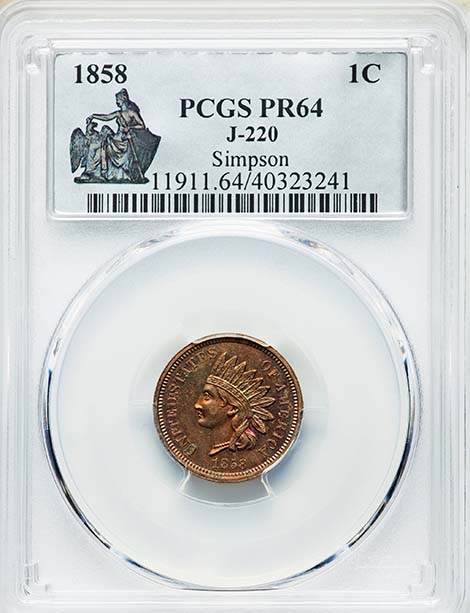
1858 Flying Eagle/Indian Cent, Judd-220, Pollock-250, Unique, PR64 PCGS. Ex: Simpson. This fantasy muling of two obverses features Paquet's smaller version of the Flying Eagle design with date below, paired with an Indian cent design with the date (centered date version) below. Struck in copper-nickel with a plain edge. The Judd reference calls this mule "one of the great numismatic curiosities of the era." It is believed to be unique. The surfaces display remarkably variegated colors on each side, which has resulted in the subduing of the original "whiteness" of the copper-nickel alloy. A few carbon spots are seen on each side. Sharply detailed throughout.
Ex: Dr. Judd (before 1940); James Sloss (Kosoff, 10/1959); Loye Lauder (William Doyle, 12/1983); Elite Auction (Superior, 1/2006), lot 1090.
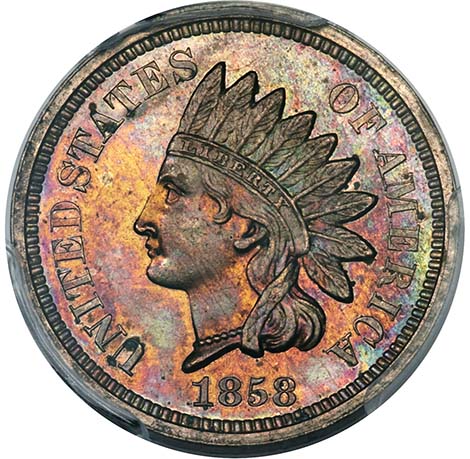
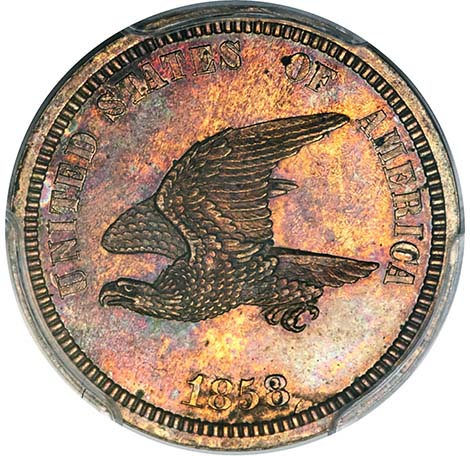
1859 Double-Headed Indian Cent
Judd-229a, MS63
Unique
Sold for: $90,000.00
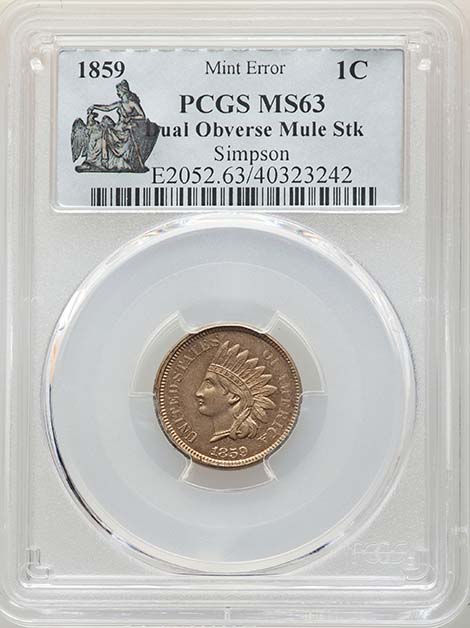
1859 Double-Headed Indian Cent, Judd-229a, Snow-PT5, Unique, MS63 PCGS. Ex: Simpson. This unusual double-obverse 1859 Indian cent, struck in copper-nickel with a plain edge and struck in business strike format not as a proof, was unknown to the numismatic community prior to the year 2000. Although its discovery was too late to appear in the Pollock pattern reference, it was included in the Judd reference beginning with the 8th edition. It was the subject of a December 2000 article by Chris Pilliod in Longacre's Ledger, and later appeared in Rick Snow's Flying Eagle & Indian Cent Attribution Guide, 2nd Edition, Volume 2 as Snow-PT5.
Rick Snow wrote, "the coin [Snow-PT5] is presently unique, and no other 1859 coins have yet been located with either of the dies. ... Neither of the dies are early die state, indicating the possibility of a large production struck prior to this coin that may have been rounded up and destroyed." In other words, the press operator detected the error, and the contents of the bin were melted. The present piece survived, perhaps retained as a souvenir by the coiner.
According to Snow, the Flying Eagle cents struck in 1858 used the obverse die as the anvil die. When production of Indian cents began in 1859, the obverse die became the hammer die. It is normally impossible to pair two obverse dies in the same press, but because die blank configurations were changed in 1859, a die made from an 1858 obverse blank could be struck with a die created from an 1859 obverse blank. This is apparently what happened.
Diagnostics for Judd-229a include a minute raised die dot between the BE in LIBERTY on one side, and a second raised die dot on the opposite side, to the west of the ear lobe. One of the dies is from a hub with a broken R in AMERICA. The other die has an intact R in AMERICA. It is also a possibility that this piece is an error. Indeed, PCGS lists it as such with the designation: Dual Obverse Mule Strike.
The present piece is sharply struck and has no indication of wear. The dies are rotated approximately 10 degrees clockwise from medal turn. The borders are sun-gold, while the fields have mellowed olive-green hues. Carbon is negligible for the grade, and there are no abrasions.
Ex: Chicago Auction (Mid-American, 6/2000); John R. Schuch; Pre-Long Beach Sale (Superior, 10/2000), lot 4017A; Legend Numismatics; private collection; Estate of Robert R. Rollins Collection, Part Three / ANA Signature (Heritage, 8/2008), lot 2154, where it sold for $195,500.
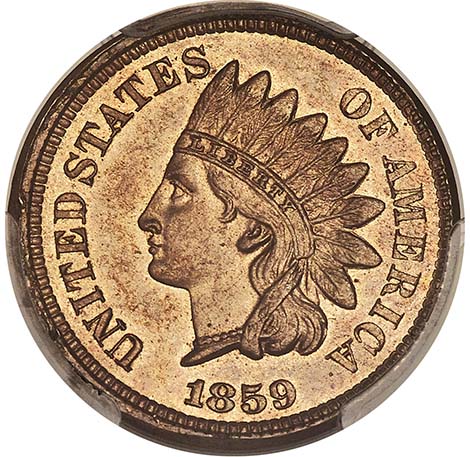
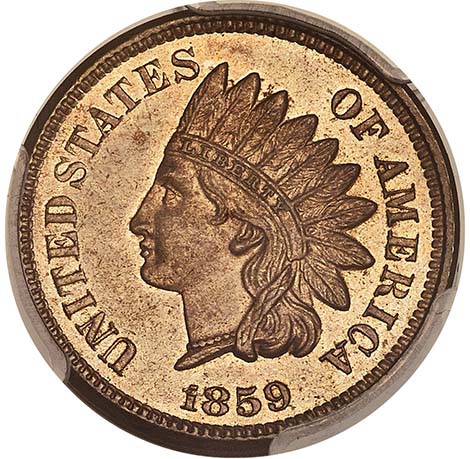
1866 Washington Five Cents
Struck in Lead / White Metal
Judd-520, PR63
Ex: Newman
Sold for: $15,600.00
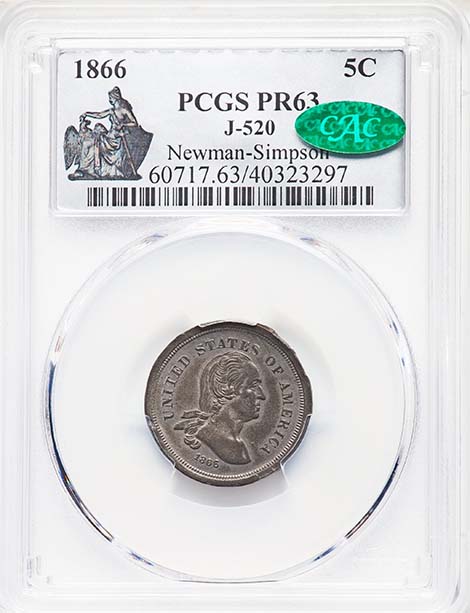
1866 Five Cents, Judd-520, Pollock-547, R.8, PR63 PCGS. CAC. Ex: Newman-Simpson. Washington portrait facing left with UNITED STATES OF AMERICA around and date below. The reverse is the Without Rays dies adopted for regular-issue coinage in 1867. Struck with a high percentage of bismuth with a plain edge, technically white metal. Medallic orientation. In the Newman catalog, the exact metallic composition was given as: 42% bismuth, 31% lead, and 22% tin. It weighs 6.0 grams. At that time, Scott Schechter from NGC commented: "While technically white metal, we generally handle alloys like this as lead if that is the only available entry in Judd. They are visually similar. While they do have slightly different specific gravities, tin is so much lower and frequently in alloy. We therefore assume the exact composition wouldn't have been known at the time the Judd reference was originally compiled."
The muling of these dies resulted in the curious display of the legend UNITED STATES OF AMERICA on both sides of the coin. These pieces are believed to have been struck from genuine dies but outside the Mint by Joseph Mickley, probably from dies sold as scrap. All the No Rays issues were overlooked by Robert Coulton Davis when he published his research in The Coin Collector's Journal in 1885. Adams and Woodin were only aware of this obverse/reverse pairing in nickel, bronze, and copper. Today we know it to be struck in nickel, copper, silver, bronze, and lead/white metal. Of these, the bronze and lead/white metal strikings are the rarest. Among the lead/white metal strikings, there appear to be two striking periods that are distinguished by an uncracked reverse and a cracked reverse. Only one other lead/white metal piece is known from the uncracked reverse. This example differs from the other lead/white metal piece with uncracked reverse as that piece (Ex: GENA, Kagin's, 10/1983) is slightly circulated and lacks the distinctive reverse spot seen on this example. There are also three known from the cracked reverse.
If indeed this piece was made by Mickley, it was remarkably well-produced. Only slight surface irregularities are seen, most of which are around the rims. The surfaces are dull gray, as one would expect from a bismuth-lead alloy, with deeper color in the centers and lighter margins. A couple of tiny field marks are seen above the tip of the bust on the obverse and a spot is noted just above the ball of the 5 on the reverse, these providing positive identification of this uncracked lead/white metal striking.
Ex: "Colonel" E.H.R. Green; Green Estate; Partnership of Eric P. Newman / B.G. Johnson d.b.a. St. Louis Stamp & Coin Co.; Eric P. Newman @ $50; Eric P. Newman Numismatic Education Society; Central States Signature / Newman I (Heritage, 4/2013), lot 3957.
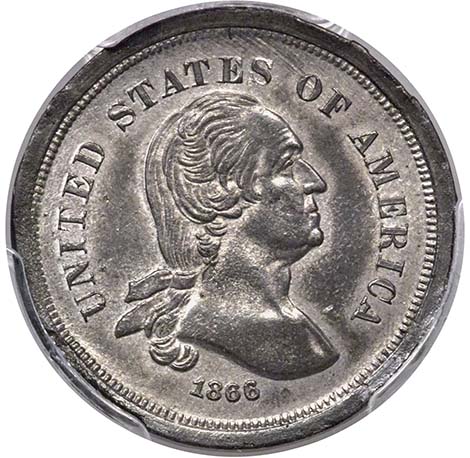
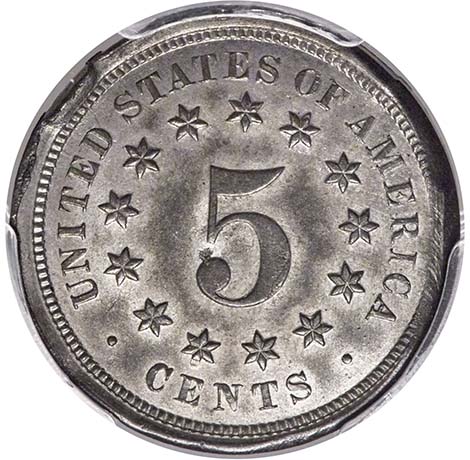
1822 Obverse Half Dollar Impression
Judd-A1822-1 in Copper, MS64 Brown
Two or Three in Private Hands
Sold for: $11,400.00
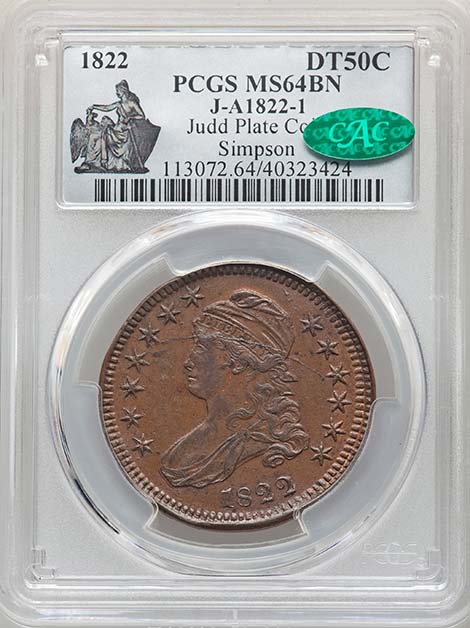
1822 Obverse Half Dollar Die Trial, Judd-A1822-1, Pollock-6215, High R.7, MS64 Brown PCGS. CAC. Ex: Simpson. A uniface obverse die trial from a regular 1822 half dollar die. Struck in copper with a plain edge. According to Andrew Pollock, this die "does not appear to match any of the 1822 obverses listed in the Overton half dollar reference, and hence it is inferred that it was never used for regular coinage production." The die may have been used to coin one or two circulation-strikes halves before failing early on, but no such examples have turned up. All Judd-A1822-1 representatives feature an arching crack across the portrait in various states. It is likely that the Mint sold the broken die, and that these impressions in copper were privately produced. Dr. Montroville Dickeson, Joseph Mickley, Edward Cogan, and John W. Haseltine are associated with such restrikes, produced during the mid-19th century.
USPatterns.com reports approximately six known examples, including two in the ANS collection and "another, the Parmelee, Byron Reed example is in the Durham Museum." Of the three that could possibly reside in private hands, only two are certified, including this piece. The other is the Garrett-Meyer example, used as the plate coin in Pollock's reference, and now certified MS62 by PCGS. A third example was offered as part of the Dr. Curtis R. Paxman Collection (Bowers and Ruddy, 11/1974), lot 1034. It may be one of the two than now reside at the ANS. This piece is plated in the Judd reference, and it was Dr. Judd who originally provided the earlier provenance to McCoy and Farouk collections. However, we can find no example in the 1954 Palace Collections catalog.
Well-centered on a slightly irregular flan, this near-Gem features glossy chocolate-brown surfaces with original mint-red color around many of the devices. Doubling and light die rust is evident throughout. The reverse is generally smooth with file marks around the rims and a patch of roughness at the lower right.
Ex: John F. McCoy Collection (W. Elliott Woodward, 5/1864), lot 1838, where it brought $3.00; Daniel Bertsch; Bach, Bertsch, et Al Collections (W. Elliott Woodward, 3/1865), lot 2870; William Harvey Strobridge; King Farouk; Dr. J. Hewitt Judd; Stewart Witham; Auction '81 (RARCOA, 8/1981), lot 306; Charlton "Swampy" Meyer; Russell J. Logan Collection (Bowers and Merena, 11/2002), lot 2411; private collector; Samuel Berngard and S.S. New York Collections (Stack's, 7/2008), lot 4152.
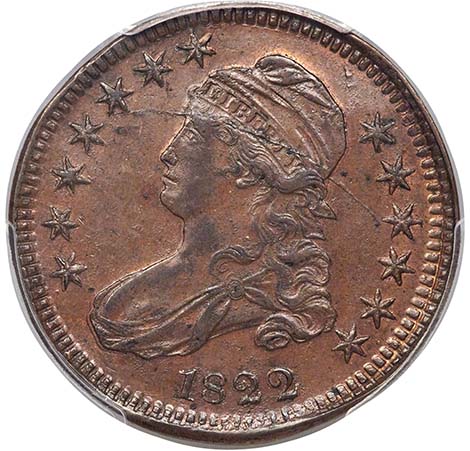
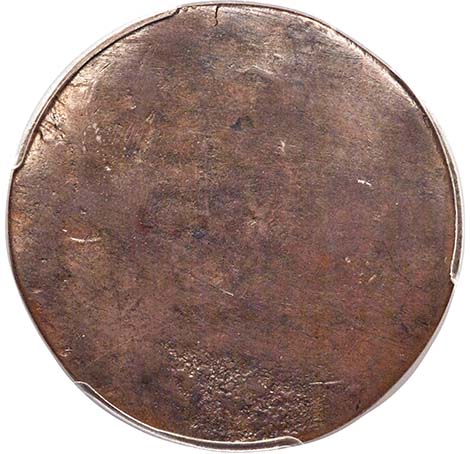
1870 Standard Silver Half Dollar, MS62
Reverse Die Trial in White Metal
Unique Judd-A1870-1
Sold for: $5,040.00

1870 Standard Silver Half Dollar Reverse Die Trial, Judd-A1870-1, Pollock-3386, Unique, MS62 PCGS. CAC. Ex: Simpson. A reverse die trial of the Standard Silver half dollar, similar to Judd-939. The denomination 50 CENTS and the date are centered within a wreath of cotton and corn, but the date is slightly higher and larger than on Judd-939. The word STANDARD has been effaced above the wreath, though faint remnants are still partially legible. Struck in white metal without a collar, so there is no edge.
This impressive and almost certainly unique splasher was created by pouring liquid white metal onto a piece of backing paper, pressing the die into the less-than-molten metal, and letting it harden. Splashers are helpful in assessing what a coin or pattern will look like without having to anneal the dies. Their nature is fleeting, however. They are extremely fragile and were never meant to be preserved, which is why so few survive. In effect, this is a pattern of a pattern and is especially interesting as such.
The obverse is brilliant silver-gray with superficial grazes along the left side. Much of the reverse backing paper remains visible amid the bubbling surfaces of the metal. Words such as "consideration," "Senate," "Messrs.," and "resolution" suggest some sort of government document. About half of the machined rim of the die is evident around the obverse from about 11:30 to 5:30, and on the corresponding area of the reverse.
Ex: Possibly S.K. Nagy; possibly 37th Sale (Thomas Elder, 2/1910), lot 291; Classics Sale (American Numismatic Rarities, 12/2003), lot 298.
